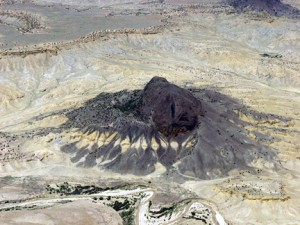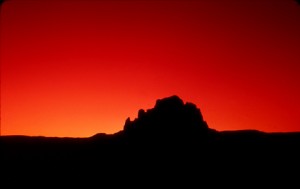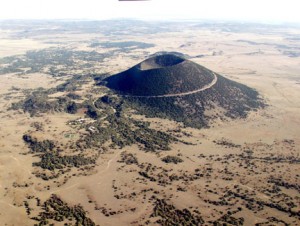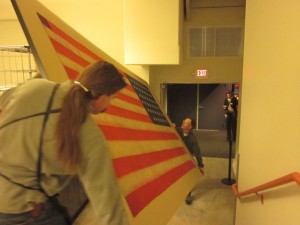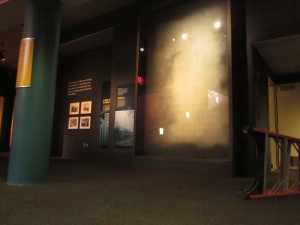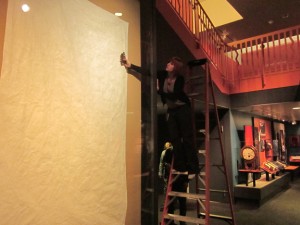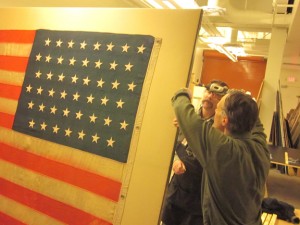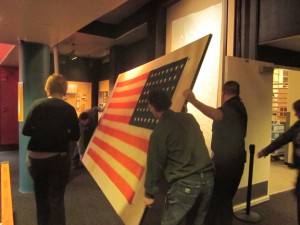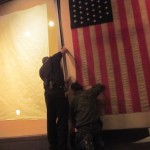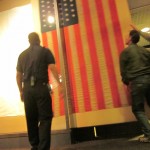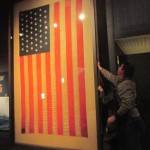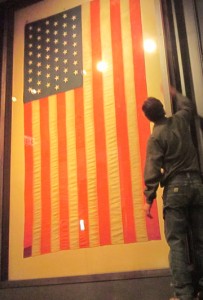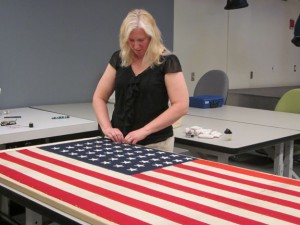On Friday morning, January 6, the New Mexico History Museum will teem with stamp geeks (a term we use with sincere fondness and respect) as the US Postal Service holds its First-Day-of-Issue ceremony for the 44-cent “forever” Centennial stamp. Honoring New Mexico’s 100th year as a state, the stamp features Sanctuary, a painting by artist Doug West that shows off a prototypical New Mexico landscape. Or at least it’s prototypical if you’re a volcanologist, which, it turns out, Larry Crumpler is.
And not just any volcanologist. Crumpler is the research curator for volcanology and space science at one of our sister institutions, the New Mexico Museum of Natural History and Science in Albuquerque. He was also part of the NASA team that developed and oversaw the Mars Exploration Rover and, in return, had a feature on that planet named after him: Larry’s Lookout (take a virtual ride toward it here).
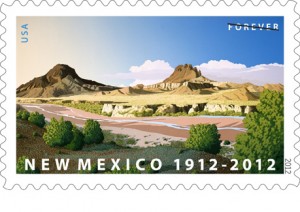 Despite those stellar creds, Crumpler insists that he had no part in helping the Postal Service choose two of what he considers “the more scenic volcanic necks” in New Mexico — or in the world.
Despite those stellar creds, Crumpler insists that he had no part in helping the Postal Service choose two of what he considers “the more scenic volcanic necks” in New Mexico — or in the world.
Some of the news stories have said the painting features Cabezon, that flat-topped volcanic plug you see between Bernalillo and Cuba, NM. In fact, Cabezon is hidden behind them. The painting features Cerro de Santa Clara (the one on the left) and Cerro Guadalupe (the one on the right). “Both are the shallow interiors of relatively young volcanoes of the Mount Taylor volcanic field exposed by the back-wasting erosion of the Rio Puerco,” Crumpler said. “The Rio Puerco volcanic necks of New Mexico are among the best exposures of the interiors of small volcanoes in the world.
“I was kind of surprised to see it on the stamp and happy to see it because I’ve been trying to get a copy of that Doug West serigraph for a number of years now, because that’s one of my favorite areas of New Mexico. It’s a part of New Mexico that’s very distinctive. You won’t see it anywhere else on the whole stinking planet.”
At one time, say, 2 million years ago, the cones were part of the Mount Taylor volcanic field, where numerous small volcanoes burbled and burped around the towering mountain. The Rio Puerco eventually cut through the field and helped erode all the soft material surrounding the lava ponds inside the volcanoes, leaving the little bumps we see today.
“If you dig underneath it, none of that rock would be down there, except for a little crack where the lava came through,” Crumpler said. “It’s like a miniature mesa.”
In his chapter for Telling New Mexico: A New History, the book produced for the opening of the New Mexico History Museum in 2009, Crumpler calls New Mexico “a giant museum of volcanoes.”
“Many Western states certainly have volcanoes, and some really spectacular and grandiose ones, too,” he writes. “But … the volcanoes here are refined, world-class examples of many different volcanic landforms, many of which are either not as well-preserved or not as abundant elsewhere.”
Today, if you walk up to the edge of Cerro de Santa Clara, you’ll see the actual crack that the lava came out of, surrounded by the ash and tuff it left behind. You’ve already seen plenty of volcanic tuff if you’ve been to Bandelier National Monument — though it’s a different remnant of a far more violent volcano. When the Valles Caldera exploded about 1 million years ago, it emitted a blanket of ash, much like a certain Icelandic volcano far more recently did. By the time it settled into a geologic formation, the Valles Caldera ash cloud had mixed with enough other substances to create a surface that after a few more millennia of erosion was deemed perfect living quarters for ancestors of today’s northern New Mexico pueblos.
Should the postage stamp whet your appetite for learning more about New Mexico volcanoes, Crumpler has three getting-started suggestions:
1. Drive to the top of Capulin Peak, an old volcano between Clayton and Raton.
2. See lava flows that he considers better than Hawaii’s at El Malpais National Monument.
3. Visit Bandelier.
And if you’re hoping to see a volcano come to life while you’re there, prepare to wait.
“There are no active volcanoes in New Mexico right now, but the conditions exist to make a new one,” Crumpler writes in Telling New Mexico. “Molten rock, or magma, is even now spreading out like pancake batter between deep rock layers about 12 miles below the surface in an area between Belen and Socorro. … The Socorro magma body may erupt someday — or maybe not. It is too early to tell.”
At 7 pm on Thursday, March 29, Crumpler will speak on “Icons of New Mexico: Volcanoes and the New Mexico Centennial Stamp” at the Natural History Museum, 1800 Mountain Road N.W. in Albuquerque. Tickets cost $6 ($5 members, $4 students). Ensure you get a seat by logging onto www.NMnaturalhistory.org or purchase tickets at the door before the talk.

